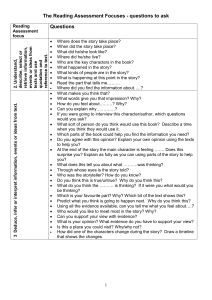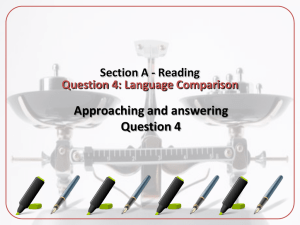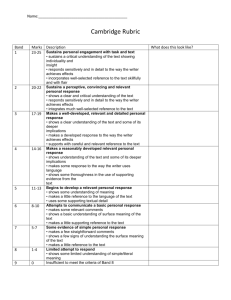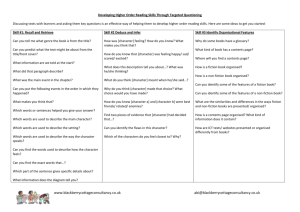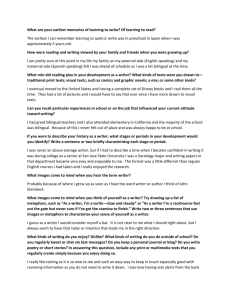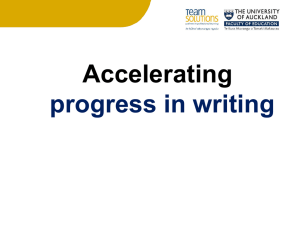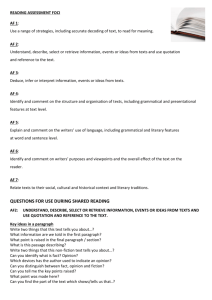here - Ecclesfield Primary School
advertisement
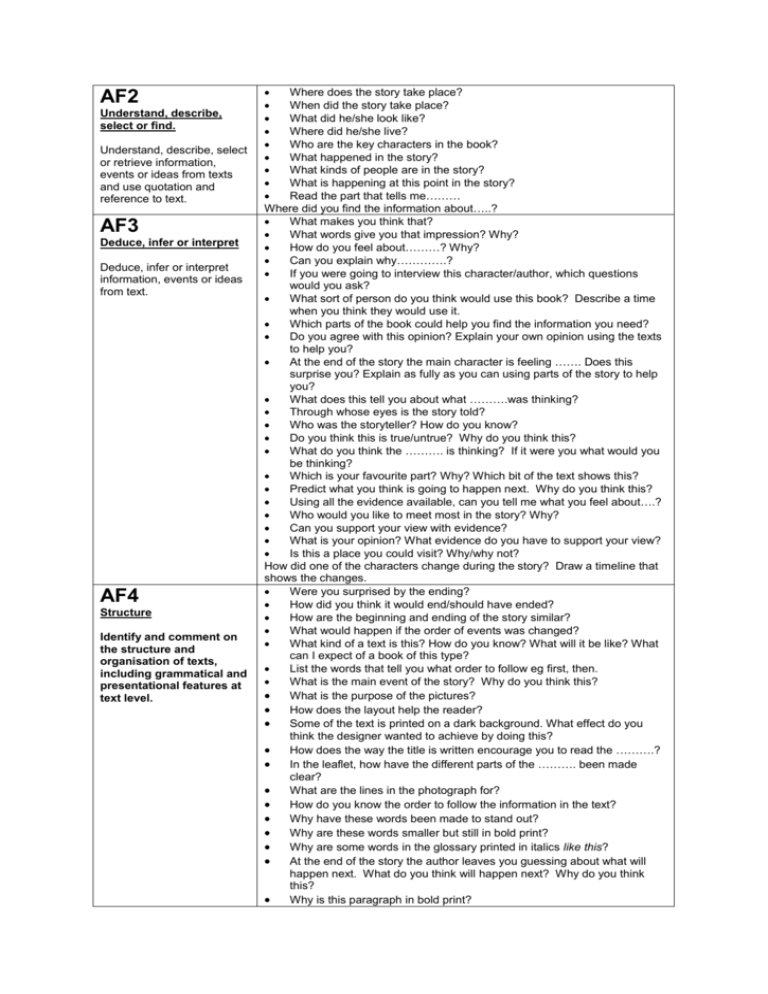
AF2 Understand, describe, select or find. Understand, describe, select or retrieve information, events or ideas from texts and use quotation and reference to text. AF3 Deduce, infer or interpret Deduce, infer or interpret information, events or ideas from text. AF4 Structure Identify and comment on the structure and organisation of texts, including grammatical and presentational features at text level. Where does the story take place? When did the story take place? What did he/she look like? Where did he/she live? Who are the key characters in the book? What happened in the story? What kinds of people are in the story? What is happening at this point in the story? Read the part that tells me……… Where did you find the information about…..? What makes you think that? What words give you that impression? Why? How do you feel about………? Why? Can you explain why………….? If you were going to interview this character/author, which questions would you ask? What sort of person do you think would use this book? Describe a time when you think they would use it. Which parts of the book could help you find the information you need? Do you agree with this opinion? Explain your own opinion using the texts to help you? At the end of the story the main character is feeling ……. Does this surprise you? Explain as fully as you can using parts of the story to help you? What does this tell you about what ……….was thinking? Through whose eyes is the story told? Who was the storyteller? How do you know? Do you think this is true/untrue? Why do you think this? What do you think the ………. is thinking? If it were you what would you be thinking? Which is your favourite part? Why? Which bit of the text shows this? Predict what you think is going to happen next. Why do you think this? Using all the evidence available, can you tell me what you feel about….? Who would you like to meet most in the story? Why? Can you support your view with evidence? What is your opinion? What evidence do you have to support your view? Is this a place you could visit? Why/why not? How did one of the characters change during the story? Draw a timeline that shows the changes. Were you surprised by the ending? How did you think it would end/should have ended? How are the beginning and ending of the story similar? What would happen if the order of events was changed? What kind of a text is this? How do you know? What will it be like? What can I expect of a book of this type? List the words that tell you what order to follow eg first, then. What is the main event of the story? Why do you think this? What is the purpose of the pictures? How does the layout help the reader? Some of the text is printed on a dark background. What effect do you think the designer wanted to achieve by doing this? How does the way the title is written encourage you to read the ……….? In the leaflet, how have the different parts of the ………. been made clear? What are the lines in the photograph for? How do you know the order to follow the information in the text? Why have these words been made to stand out? Why are these words smaller but still in bold print? Why are some words in the glossary printed in italics like this? At the end of the story the author leaves you guessing about what will happen next. What do you think will happen next? Why do you think this? Why is this paragraph in bold print? AF5 Use of Language Explain and comment on the writers’ uses of language, including grammatical and literary features at word and sentence level. AF6 The effect of the text Identify and comment on writers’ purposes and viewpoints and the overall effect of the text to the reader. AF7 Cultural / Historic traditions What are the subheadings for? Why has some of the information been presented as a table? What is the purpose of the writing in the boxes? What do the arrows show you about the structure of the text? I wonder what the writer intended by using these words? What do these words mean and why do you think the writer chose them? How has the author used adjectives to make this character funny? What do the physical descriptions of characters tell us about how they are feeling? Look at the verbs/adjectives/adverbs, what do these words tell us about…………? By writing the line in this way, what effect has the author created? What do these words tell you about ………? Which word encourages you to read the ………..? What does the word scrambled tell you about the way Legs got dressed? Why do you think the author has mentioned ……… a lot in the story? Explain what you think this phrase adds to the story. Why did the author choose this title? What is the effect of writing in the past/present tense? Why do you think the writer has chosen to use the words ……………………..? Why do you think the author has written this sentence in this way? Which author’s style did you enjoy the most? Why? Do you want to read the rest of the text? How does the writer encourage you to read the rest of the text? How do these phrases help to make the description effective? How does the author make the …………… appear frightening? Which part of the story best describes the setting? Which words and /or phrases do this? Can you think of another story that has a similar theme eg good over evil, weak over strong, wise over foolish? I wonder why the writer has decided to…? What was in the author’s mind? Why did the author chose this setting? How would the views put across in these texts affect your views on….? What makes this a successful story? What evidence do you have to justify your opinion? Could it be better? Is it as good as…..? What effect does it have on you as a reader? Why do you think the writer wrote that description? What is the author trying to tell you about………by writing this section in …….? (eg short lines) What was the most exciting part of the story? Explain your answer as fully as you can? Which illustrations did you find most useful? Do you think that the writer believes that ………… exist? How can you tell that the writer has this opinion? What are the main contrasts the poet makes in the third and first parts of the poem? What impression of ………..does the first paragraph give you? In what ways is the second paragraph different? The texts try to make you care about …………… Which do you think is the most effective? Why? What is …………… opinion about …………….? If …………… was alive today would he be arguing for ………………? What do you think makes this a successful story? Use evidence from the text for your answer? Do you know another story, which deals with the same issues eg social, cultural, moral ? What would this character think about…….? (Possibly a present day issue) Do you know any more stories like this? Relate texts to their social, cultural and historical contexts and literary traditions. Have you ever read a book with a similar theme to this one? What does this remind you of? What does it make you think of? Do you know any more stories like this? Does this story remind you of any personal experience? Have you ever been in that situation? What happened? How would you have felt in the same situation? What might you have done instead? Can you compare …………. to a person who has frightened you? How would you feel if you were treated like ……….? What would you do? What do you think would have happened if…………? Are there any familiar patterns you notice eg familiar story structure, imagery? What kind of a text is this? How do you know? What will it be like? What can I expect? Many traditional tales have messages. What do you think this story is trying to tell us? Which stories have openings like this? Do you know any other texts with similar issues or themes? Do you know another story with these characters in? Can you think of another story where the main character has problems with their family?
